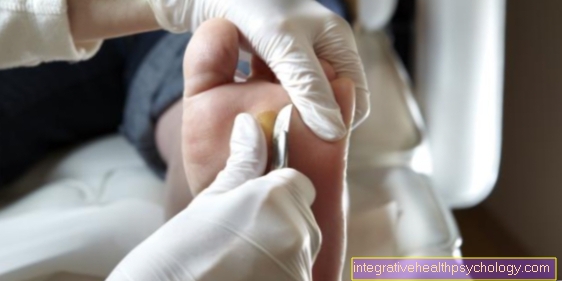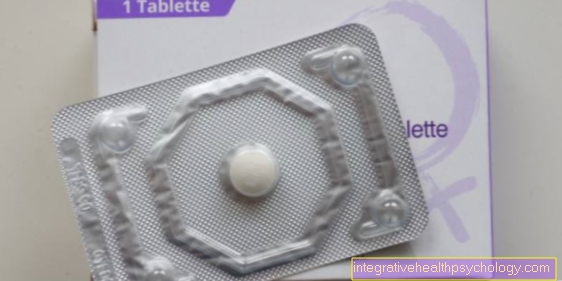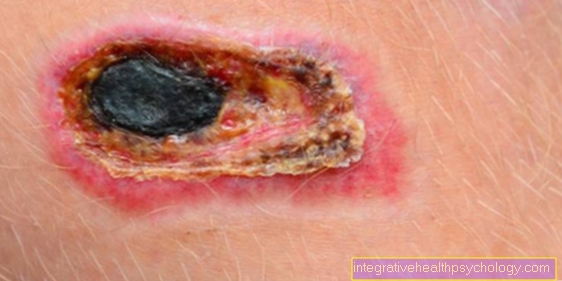Abscess on the cheek
definition
An abscess on the cheek is a collection of pus that is located in a cavity that has been newly formed by melting tissue and is separated from the surrounding tissue by a thin membranous capsule.
Colloquially, an abscess is also referred to as a boil and those affected suffer from a "big cheek". Depending on the cause, the abscess on the cheek can either be on the outside of the skin of the face or on the inside of the lining of the cheek.

Causes of an abscess on the cheek
Abscesses on the cheeks occur when bacteria get into the tissue through small injuries to the skin or mucous membrane and cause an infection there. Most of the causative agents of purulent abscesses are bacteria of the genus Staphylococcus, the most common of which is Staphylococcus aureus. These bacteria are naturally found on the surface of everyone's body and usually do not cause any problems there.
However, if the bacteria get under the skin and multiply there, the body reacts with an inflammatory reaction. In the case of an abscess, the immune system is unable to fully fight the bacteria. Because of this, the body uses a thin capsule to encapsulate the infection from the surrounding tissue, which prevents the inflammation from spreading. Especially people with a weakened immune system (for example people with poorly controlled diabetes mellitus or immunosuppressed people after a transplant) are particularly prone to the formation of abscesses.
The causes of an abscess on the cheek are many. Often an abscess forms on the outside of the cheek as a result of a severely inflamed pus pimple. By pressing on an immature pimple, bacteria are squeezed into the tissue and lead to abscess formation. Another cause of abscesses on the cheek is piercings, known as cheeks. By damaging the skin during piercing, bacteria get into the tissue and form an abscess. But tooth inflammation, severe periodontitis or jaw inflammation can also lead to abscess formation on the cheek.
You might also be interested in this topic:
- Causes of an Abscess
- Abscess on the face- when should you see a doctor?
Symptoms of an abscess on the cheek
An abscess on the cheek leads to the classic signs of inflammation, whereby the severity of the symptoms depends primarily on the severity of the inflammation and the exact location of the abscess. Due to the inflammatory reaction, the tissue around the abscess is severely swollen, reddened and the skin feels warm. The cheek on the affected side is "thick" due to the swelling and the affected people sometimes feel severe pain, which makes them very sensitive to touching the face.
The pain and swelling can also affect the way your mouth works. This means that the abscess on the cheek is causing problems speaking, chewing, and swallowing. Those affected also find opening their mouths and eating or drinking very painful.
In the worst case, pus and bacteria from the abscess can get into the bloodstream and cause blood poisoning (sepsis) there. The sick people then feel very sick and have a high fever, which is why a doctor or hospital must be consulted immediately. Sepsis is a serious complication of an abscess that can even lead to multiple organ failure and death.
Read more on the topic: Symptoms of blood poisoning
Abscess after a pimple
A pus pimple on the cheek is already a small abscess, but it is relatively harmless. However, sometimes a simple pus pimple on the cheek can turn into a dangerous abscess. This happens mainly through unprofessional pushing around on the pimple, whereby bacteria from the skin are squeezed deep into the tissue and can lead to severe inflammation.
Therefore, skin imperfections should only be expressed with a clean handkerchief or by a beautician. If an abscess has formed from the pimple, this can be recognized by the severe swelling and reddening of the skin. The abscess on the cheek can either be treated with pulling ointment or, in the worst case, must be cut open.
Read more on the topic: How to Get Rid of Pimples
Abscess on the inner lining of the cheek
Abscesses that form on the inside of the cheek mucous membrane are often caused by diseases of the teeth and the gums. These include purulent periodontitis, severe tooth inflammation or inflamed wounds after a tooth has been removed. But even a small injury to the oral mucosa is enough for bacteria to penetrate the tissue and cause an encapsulated inflammation there. Sometimes the bacteria are also spread into the mouth from another part of the body via the bloodstream and then encapsulate there. However, the exact cause of an abscess formation on the inside of the cheek is often not entirely clear.
An abscess on the inside of the cheek is diagnosed by a dentist. The doctor cuts the abscess through a small incision on the lining of the cheek and allows the collected pus to drain away. The procedure takes place under local anesthesia. After the abscess has been cut open and emptied, those affected feel an immediate improvement in their symptoms. The doctor then prescribes antibiotics. This supports the healing process and also prevents an abscess from immediately forming again in the same place.
You might also be interested in this topic: Abscess in the mouth
Pus from an abscess on the cheek
An abscess on the cheek is an encapsulated collection of pus under the skin.
The pus is a whitish liquid that forms from dead tissue, lost white blood cells, and bacteria. As the tissue dies, a newly created cavity forms in which the pus can accumulate. When an abscess matures, the collection of pus is visible as a white head. The doctor cuts out the abscess and lets the pus drain away. Since the purulent liquid contains bacteria, it is still infectious and must be completely removed from the wound, otherwise an abscess can quickly form again.
diagnosis
The doctor diagnoses an abscess on the cheek based on the typical clinical appearance: the skin over the abscess is very swollen, warm and reddened. Due to the severe swelling, those affected feel a feeling of tension and more or less pronounced pain in the inflamed area.
Blood may also be drawn to check inflammatory levels such as CRP and leukocytes (white blood cells). In some cases, the doctor can also puncture the abscess and microbiologically diagnose the bacteria in the pus to prescribe an appropriate antibiotic.
Treatment of an abscess in the cheek
Treatment for an abscess on the cheek depends on the severity of the inflammation and the exact location of the abscess. Smaller abscesses on the outside of the skin of the face can possibly be treated with pulling ointment.
Larger abscesses indicate severe inflammation and must definitely be treated by a doctor. Abscesses on the inside of the cheek mucosa should also be treated immediately by a dentist.
The only way to permanently treat an abscess is to cut it open. The doctor performs the minor surgery under local anesthesia. A small incision in the skin is used to split the abscess on the cheek and the accumulated pus can drain away. Then it is rinsed with an antiseptic liquid and the wound is covered with compresses. It is not sutured to prevent bacteria from encapsulating again immediately and forming a new abscess. In some cases, the doctor may then prescribe drug therapy with antibiotics. After the abscess is split, the wound usually heals completely within a few days, but the incision can leave a fine white scar.
Read more on the topic: Therapy for an abscess
Duration of an abscess
An abscess on the cheek lasts about one to two weeks, depending on the size and treatment. Small abscesses heal relatively quickly using a pulling ointment, whereas larger abscesses take more time. In general, the faster the abscess is treated, the shorter the duration of the illness.
Abscesses on the inside of the cheek in particular can cause serious problems and last a long time, which is why a doctor should be consulted immediately if an abscess is suspected. After the abscess has been cut open, the pain and discomfort are relieved very quickly and the wound heals after a few days with antibiotics.
You might also be interested in this topic: Abscess or boil


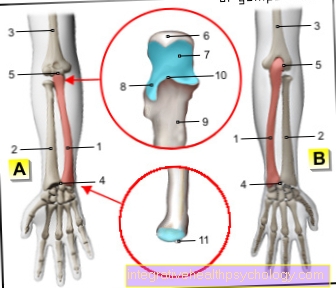
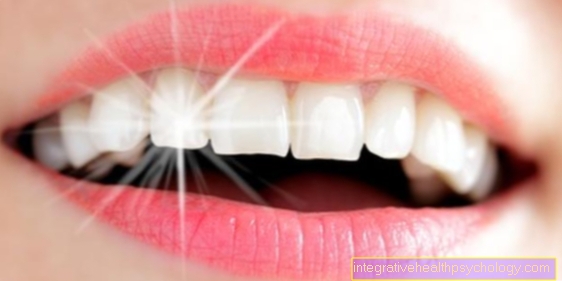

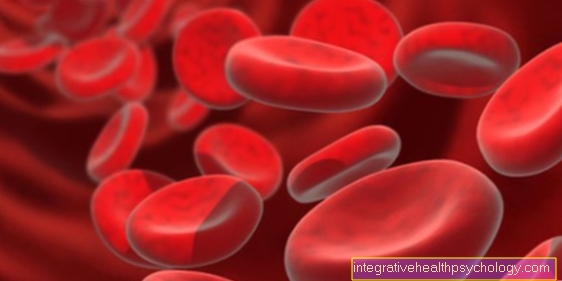



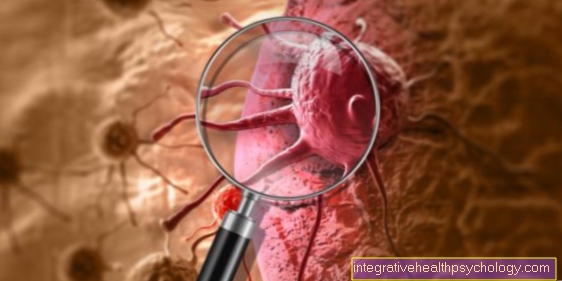



.jpg)








